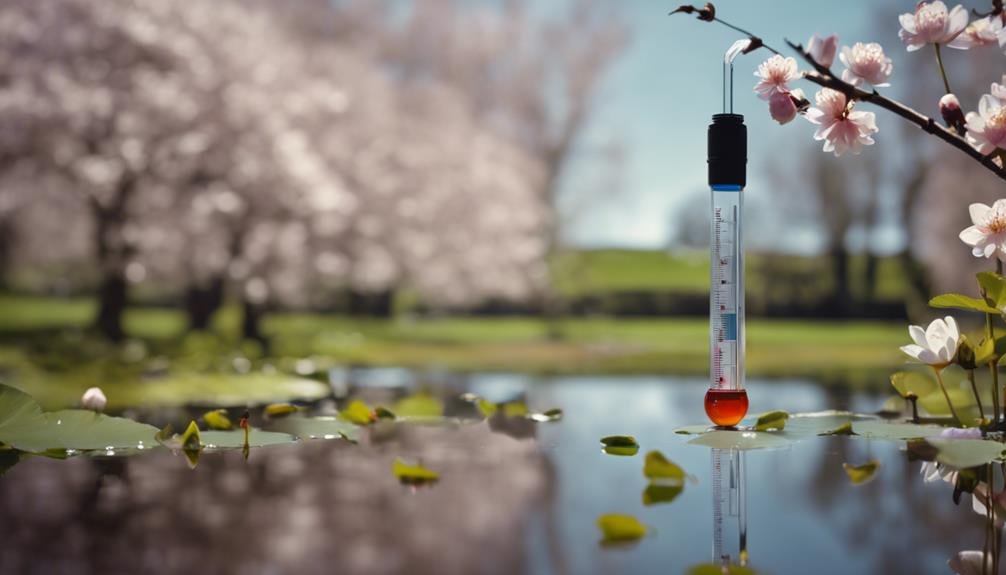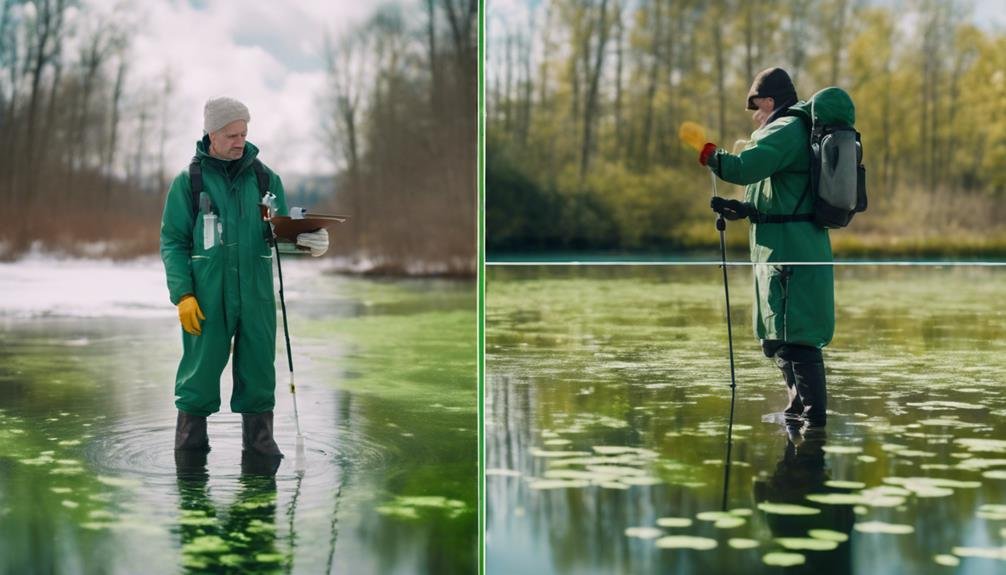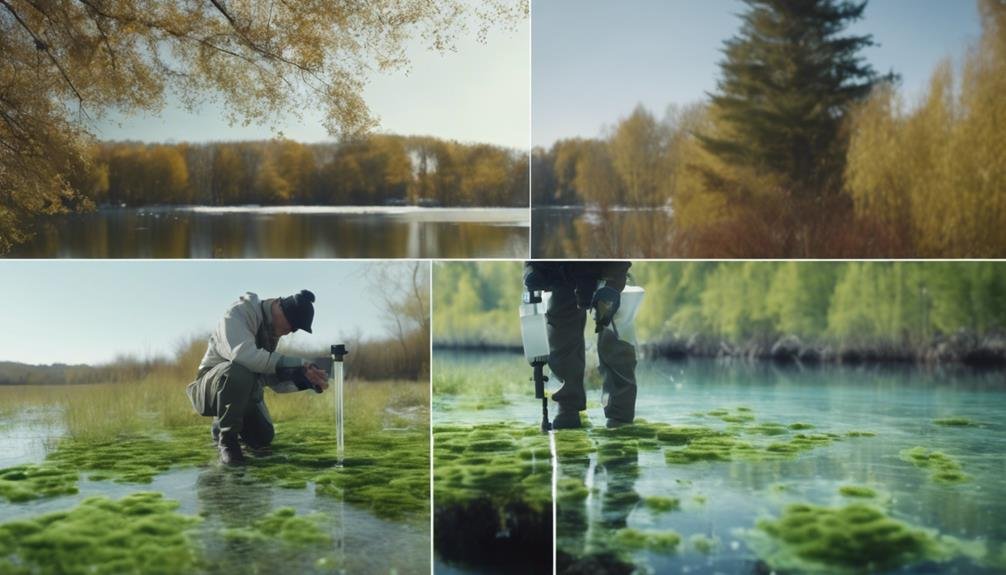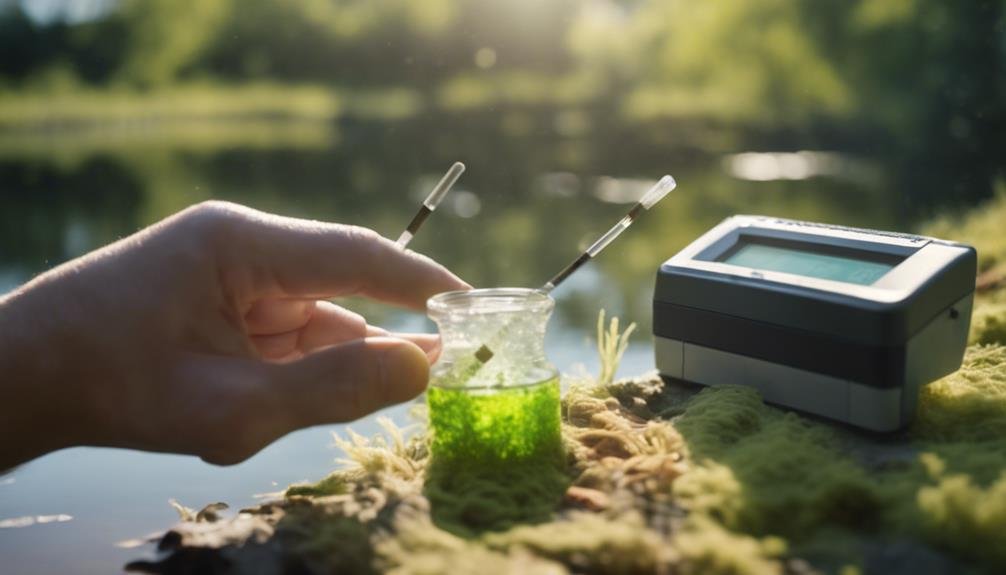You'll need to adjust your water testing practices throughout the year to maintain ideal quality. In summer, increase testing frequency and monitor pH, chlorine, and alkalinity closely. Winter requires more frequent checks and possible heater adjustments for aquariums. Spring calls for monitoring temperature fluctuations and biological activity in ponds. Fall demands attention to pH, alkalinity, and chlorine effectiveness. Year-round, be prepared to modify chemical dosages and filtration methods based on seasonal changes. Temperature impacts biological activity and nutrient uptake, so adapt your testing schedule accordingly. A well-planned, flexible testing routine is essential for keeping your water balanced in every season. Further exploration will reveal more specific seasonal strategies.
Summer Water Testing Essentials
Explore summer water testing essentials to keep your pool safe and sparkling during the hottest months. The summer season brings unique challenges for pool maintenance, requiring increased vigilance in your water testing routine.
You'll need to test your pool water more frequently during summer due to higher temperatures and increased usage. Pay close attention to pH levels, as they tend to fluctuate more in hot weather.
Monitor chlorine levels closely, as they can dissipate faster in sunlight. It's important to maintain proper alkalinity and hardness within recommended ranges to prevent water chemistry imbalances.
For outdoor pools, regularly testing cyanuric acid levels is essential to maintain effective chlorine stabilization. This compound helps protect chlorine from rapid breakdown due to UV rays.
Winter Aquarium Maintenance Strategies
As winter sets in, you'll need to adjust your aquarium maintenance routine to keep your underwater ecosystem thriving in cooler temperatures. The colder weather can affect water temperature, which in turn impacts your fish's metabolism and activity levels. It's essential to monitor water quality more frequently during this season, as fluctuations in parameters like pH and ammonia levels are more common.
To maintain stable conditions, consider using a water heater, especially if you have tropical fish. This will help keep the water temperature consistent, reducing stress on your aquatic inhabitants.
You'll also need to adjust feeding schedules, as fish typically require less food when their metabolism slows in cooler water.
Be mindful of how indoor heating systems might affect humidity levels and water evaporation rates in your aquarium. Increased evaporation can lead to changes in water chemistry, so you may need to top up your tank more often.
Regular water testing becomes even more important during winter to catch any potential issues early. By staying vigilant and adapting your maintenance routine, you can make sure your aquarium remains healthy throughout the colder months.
Spring Pond Care Guidelines

Spring brings a fresh set of challenges for pond owners, requiring adjustments to your water testing practices and care routines. As the season changes, you'll need to increase the frequency of your water tests to monitor pH, ammonia, nitrites, and nitrates. These tests are essential for maintaining a balanced ecosystem for your fish and plants.
When collecting water samples, consider seasonal factors like runoff from melting snow and increased rainfall. These can impact your pond's water chemistry, potentially leading to imbalances or nutrient deficiencies. You'll need to adjust water treatments based on your test results to address any issues that arise.
Keep in mind that spring's environmental changes can affect your pond in several ways:
- Temperature fluctuations can stress fish and alter water chemistry
- Increased biological activity may lead to rapid changes in nutrient levels
- New plant growth can impact oxygen levels and nutrient uptake
- Changing light conditions might affect algae growth
As you monitor these factors, pay close attention to plant growth and any signs of nutrient deficiencies. By staying vigilant with your water testing and adjusting your care routine accordingly, you'll guarantee your pond remains healthy throughout the spring season.
Fall Water Quality Management
During fall, you'll need to adjust your water quality management practices to address the unique challenges this season brings to your pool. As leaves and debris fall into your pool, they can affect the chemical balance, requiring more frequent water testing. You'll want to pay close attention to several key factors:
| Factor | Fall Impact | Testing Frequency | Adjustment Needed |
|---|---|---|---|
| pH Levels | Fluctuate more | 2-3 times/week | Add pH increaser or decreaser |
| Alkalinity | May rise | Weekly | Add alkalinity decreaser if needed |
| Hardness | Can shift | Bi-weekly | Adjust with calcium hardness increaser |
| Chlorine | Less effective | 2-3 times/week | Increase dosage as needed |
Fall's decreased sunlight and lower temperatures can impact chlorine effectiveness, so you may need to adjust your dosages. Alkalinity levels might rise due to increased rainfall, requiring careful monitoring. Hardness levels can also shift, potentially affecting water clarity. To maintain proper fall water quality, you'll need to test more frequently and be prepared to make adjustments. By staying vigilant with your water testing routine and responding promptly to changes, you can keep your pool in optimal condition throughout the autumn months.
Seasonal Parameter Fluctuations

While fall presents its own set of challenges, you'll find that water parameters fluctuate throughout all seasons, requiring year-round attention to maintain peak quality. Seasonal changes have a notable impact on water pH levels, alkalinity, hardness, and electrical conductivity. These fluctuations are primarily due to variations in temperature, rainfall, and changes in water sources and mineral content.
To effectively manage these seasonal parameter fluctuations, you should:
- Regularly test water pH levels
- Monitor alkalinity fluctuations
- Track hardness levels
- Measure electrical conductivity shifts
By consistently monitoring these parameters, you'll be better equipped to adjust your water treatment practices accordingly. For instance, you may need to modify chemical dosages or filtration methods to compensate for seasonal changes in water quality.
Understanding these fluctuations is essential for maintaining top-notch water quality year-round. pH levels may shift due to temperature changes, while alkalinity can fluctuate with seasonal variations in rainfall. Hardness levels often change as water sources and mineral content vary throughout the year. Additionally, electrical conductivity may shift due to seasonal changes in dissolved solids, such as nutrients and minerals.
Temperature-Dependent Testing Frequency
You'll need to ramp up your water testing frequency as temperatures rise, ensuring you stay ahead of rapid chemical changes in your pool or water system. Warmer water accelerates chemical reactions, affecting key parameters like pH, alkalinity, and chlorine levels. To maintain essential water quality and safety, it's vital to increase your testing to at least twice a week during warmer seasons.
Higher temperatures also promote algae growth, necessitating more frequent testing and adjustments. By being proactive and adjusting your testing schedule based on temperature fluctuations, you can prevent imbalances in water chemistry. Remember to adjust chemical dosages based on your test results.
Here's a quick guide to temperature-dependent testing frequency:
| Water Temperature | Testing Frequency | Parameters to Monitor |
|---|---|---|
| Below 60°F (15°C) | Weekly | pH, Alkalinity, Chlorine |
| 60-75°F (15-24°C) | Twice weekly | pH, Alkalinity, Chlorine, Cyanuric Acid |
| Above 75°F (24°C) | Every 2-3 days | All parameters, including Calcium Hardness |
| Above 85°F (29°C) | Daily | All parameters, with extra focus on Chlorine |
Algae Growth and Nutrient Monitoring

As temperatures rise, you'll need to closely monitor algae growth and nutrient levels in your water system to maintain a healthy balance. Warmer seasons bring increased sunlight and nutrient availability, leading to accelerated algae growth.
To prevent nutrient imbalances, adjust your water testing frequency during summer months. This important approach helps control algae blooms and maintains a balanced aquatic ecosystem.
Regular nutrient monitoring is vital during peak algae growth periods. Focus on testing for phosphates and nitrates, as these are key nutrients that fuel algae proliferation. Higher water temperatures can speed up nutrient uptake by plants and algae, making frequent testing even more important.
To effectively manage your water system during warmer seasons:
- Increase water testing frequency to catch nutrient imbalances early
- Monitor phosphate and nitrate levels closely
- Observe changes in algae growth patterns
- Adjust your management strategies based on test results
Cold Weather Ph Considerations
Shifting our focus from warm-weather concerns, it's important to recognize that cold weather brings its own set of challenges for maintaining proper pH levels in your water system. As temperatures drop, you'll notice that pH levels in your pool tend to rise. This is due to decreased chemical activity and increased rainfall dilution, which can greatly impact water balance.
During colder months, it's essential to adjust pH levels to prevent equipment damage and maintain ideal water quality. Cold weather can cause pH fluctuations, affecting water clarity and reducing the effectiveness of sanitizers.
To guarantee a safe and enjoyable swimming experience, you'll need to implement regular monitoring and adjustment practices.
Adapting to Changing Biological Activity

Throughout the changing seasons, you'll need to adapt your water testing practices in response to fluctuations in biological activity. As temperatures rise, increased biological processes can lead to faster changes in water chemistry. This means you'll likely need to test more frequently during warmer months to keep up with these rapid shifts.
When adapting your water testing routine to seasonal changes, consider the following:
- Increase testing frequency in summer to monitor pH levels and nutrient availability
- Pay close attention to algae growth, which can affect water clarity and plant nutrient uptake
- Adjust your testing schedule in winter when biological processes slow down
- Be prepared to make more frequent adjustments to maintain ideal water quality in warmer seasons
Water temperature plays an important role in biological activity, impacting pH levels and nutrient availability for plants. In summer, you may notice more rapid fluctuations in these parameters due to increased algae growth and overall biological activity.
Conversely, winter's colder temperatures tend to slow down these processes, resulting in more stable water parameters. By adjusting your testing frequency based on seasonal changes, you'll be better equipped to maintain ideal water quality for aquatic life year-round.
Year-Round Water Testing Schedule
You'll need a well-planned year-round water testing schedule to maintain consistent pool chemistry and water quality across all seasons. A regular testing routine is essential for pool chemistry stability and peak water quality. However, it's important to adjust your testing frequency based on various factors throughout the year.
During peak swim season, typically in hot summer months, you should increase your testing frequency. This is when algae growth is more likely, and higher bather loads can quickly affect water quality.
In spring, consider ramping up your testing schedule to address winter debris accumulation and prepare for summer use. As weather changes occur, be prepared to adapt your testing routine accordingly.
Your year-round water testing schedule should be flexible enough to accommodate fluctuations in pool activity levels and environmental conditions. For example, you may need to test more often during periods of heavy rainfall or when hosting pool parties.
Frequently Asked Questions
How Frequent Should We Do Water Testing Depending on the Risk?
You should test your water weekly during high-risk seasons and bi-weekly or monthly in low-risk periods. Adjust your frequency based on temperature, rainfall, and pool usage to catch potential issues early and maintain proper chemical balance.
What Are the Four Methods Used for Water Quality Testing?
You might think water testing is complex, but it's essential. The four main methods you'll encounter are colorimetric, electrochemical, turbidimetric, and gravimetric tests. Each provides unique insights into water quality, helping you guarantee safe, clean water.
How Long Can a Water Sample Sit Before Testing?
You should test your water sample within 24 hours for the most accurate results. If you can't, store it in a cool, dark place. Remember, the longer you wait, the less reliable your test results become.
What Are the Standard Practices for Sampling Water?
Did you know 90% of pool water issues stem from improper sampling? You'll want to collect samples from mid-pool or both ends at elbow depth. Test immediately and use unique ID numbers for tracking. It's essential to capture overall conditions.
Conclusion
As you navigate the ebb and flow of seasonal water testing, you'll find that adapting your practices is key. Like a skilled sailor adjusting their sails, you'll learn to fine-tune your approach based on nature's rhythms.
Remember, water quality isn't static—it's a living, breathing entity that demands your constant attention.
By following these seasonal guidelines, you'll guarantee your aquatic environments remain healthy and balanced throughout the year, come rain or shine.

